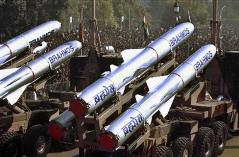Bravo BRAHMOS
The Hindu (March 25, 2010) Print This NewsThe successful flight of the BrahMos missile on March 21 spotlights India's status as a world leader in launching supersonic cruise missiles vertically from moving warships and manoeuvring the missiles at the supersonic speed of 2.8 Mach. Launching a missile in an inclined mode is relatively easy. But lifting off vertically from a rolling and pitching vessel, climbing, turning and cruising horizontally, performing manoeuvres, and precisely hitting the target is technologically a big task. Astonishingly, BrahMos performed its intricate manoeuvres at 2.8 Mach, with its propulsion fully switched on during the whole course of its flight. (Normally, when a missile performs manoeuvres, its engines will not operate.) Another highlight was the advanced indigenous software for way point manoeuvring that enables the low-flying missile to hit a target vessel taking shelter, for instance, behind a rocky island. This was the 22nd launch of BrahMos, a joint venture product of the Defence Research and Development Organisation of India and NPO Mashinostroyenia, a space-missile enterprise of the Russian Federation. BrahMos is a versatile, two-stage missile that is nine metres long and weighs 3.9 tonnes with the canister. It has a range of 290 km. It can carry only non-nuclear warheads. With a flight record demonstrating a high degree of reliability, it has already been inducted into the Navy and the Army. India has ship-to-ship, ship-to-land, land-to-land, and land-to-ship versions of BrahMos.
Nobody in their right mind wants lethal missiles fired to kill, destroy, and inflict damage on civilian targets. Since the Brahmos missile is all about enhancing defence capability, a vertical launch from a ship has several advantages. First, it ensures the vessel's safety because the missile is pushed out vertically and its booster engine is fired in the air, allowing the ship to move away. Secondly, the missile in vertical launch can take on a target lying anywhere in a 360-degree range. Whatever the ship's orientation, the missile can turn in any direction to pursue the target. Thirdly, the vertical placement enables accommodation of more missiles in less space in a warship's cramped environs. The missiles are concealed inside the ship, providing them with long and safe storage and protection against corrosion. With India declaring that it would not use nuclear weapons first against another country, BrahMos becomes a formidable and highly cost-effective defence because it can hit any attacker with speed, power, and precision. Given its fast reaction — it takes off in four minutes from the time the command is given from launch headquarters — the missile has virtually no equal in a hypothetical conventional battlefield. BrahMos is a state-of-the-art demonstration of the great advantages of Indo-Soviet, and now Indo-Russian, defence cooperation.




























 Dr. Jaiteerth R. Joshi is an outstanding defence scientist renowned for his distinct leadership in the design, development, strategic planning & production of tactical missile systems of the country. He has led various initiatives in Joint development of Long Range Surface to Air Missile (LRSAM) & Medium Range Surface to Air Missile (MRSAM).
Dr. Jaiteerth R. Joshi is an outstanding defence scientist renowned for his distinct leadership in the design, development, strategic planning & production of tactical missile systems of the country. He has led various initiatives in Joint development of Long Range Surface to Air Missile (LRSAM) & Medium Range Surface to Air Missile (MRSAM).
